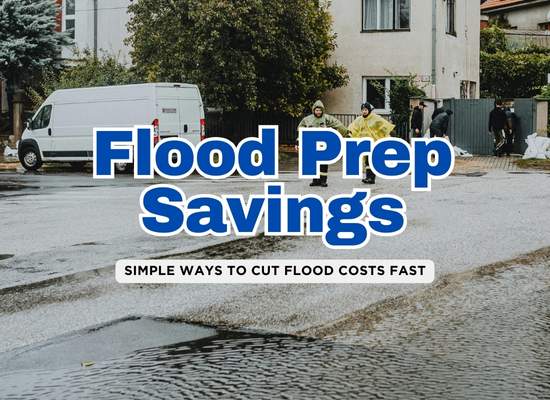Floods are unpredictable, but your expenses don’t have to be. From rising insurance premiums to costly recovery, flood-related damage can drain your wallet fast. But here’s the good news: you don’t need to break the bank to stay protected. Smart planning, the right tools, and a few strategic upgrades can help you defend your property and save serious money—before the waters ever rise.
🏠 Flood Protection Savings Calculator
Select what you’ve done or plan to do:
Let’s explore some top cost-saving strategies that reduce risk and long-term expenses.
🧭 Get a Flood Risk Assessment Before You Spend
Before investing in sandbags or pumps, know what you’re really up against. A professional flood risk assessment (or a solid DIY one using FEMA maps and local data) helps you understand:
- If you’re in a high, moderate, or low-risk zone
- Where water is most likely to enter your property
- Whether drainage or elevation is your biggest problem
Why it saves money:
You’ll avoid wasting money on one-size-fits-all solutions. For example, if your property is mainly at risk from groundwater seepage—not rising river levels—focusing on foundation sealing and sump pumps makes more sense than piling up sandbags.
FloodMart Tip: Many communities offer free or low-cost assessments through local floodplain managers or emergency services.
🧱 Invest in Reusable Flood Barriers Instead of Sandbags
Sandbags are cheap up front but costly in the long run. They’re labor-intensive, need to be replaced after every flood, and often end up in landfills.
A better option? Reusable flood barriers. Options like water-filled tubes, quick-deploy panel systems, or stackable blocks are:
- Faster to set up
- Easier to store
- Reusable for years
Why it saves money:
Over multiple storms, the upfront cost of a reusable system pays off. Plus, cleanup is easier and less expensive.
FloodMart Tip: Start small—protect the most vulnerable entry point first (like a garage or back door) and expand over time.
🚿 Improve Drainage Before It Becomes a Disaster
Proper drainage is one of the most overlooked and cost-effective defenses against flooding. Even simple upgrades like French drains, gutter extensions, and driveway grading can redirect water away from your home before it pools.
Why it saves money:
Good drainage reduces the risk of basement flooding, mold, and foundation damage—all of which come with major repair costs. It’s often cheaper than interior waterproofing and far less disruptive.
FloodMart Tip: After a heavy rain, walk around your property and look for puddling areas or water trails—those are your weak spots.
🔌 Elevate Utilities and Critical Equipment
When floodwaters hit, it’s not just furniture that gets ruined. Water heaters, HVAC systems, electrical panels, and even laundry machines are often located in basements or low areas—prime targets for flood damage.
Why it saves money:
Repairing or replacing flooded utility equipment is expensive, and not always fully covered by insurance. Elevating now is often far cheaper than emergency replacement later.
FloodMart Tip:
Use concrete platforms or wall mounts to lift units above flood level, and check with your insurer—some offer discounts for mitigation steps like this.
🛠️ Use Flood-Resistant Materials for Repairs
If your home has ever flooded before—or you’re in a flood-prone zone—think carefully about the materials you use during repairs or renovations. Drywall, insulation, flooring, and baseboards all come in flood-resistant options that can drastically reduce future damage.
Why it saves money:
Standard drywall and carpet often need full replacement after even minor flooding. Materials like closed-cell insulation, ceramic tile, and composite baseboards can be cleaned and reused, slashing your recovery costs.
FloodMart Tip:
Look for products labeled “flood-resistant” or “water-tolerant”—they may cost slightly more upfront but save big in the long run.
🧾 Check for Local Rebates and Government Assistance
Many cities, counties, and FEMA programs offer rebates or financial assistance for homeowners making flood-prevention upgrades. This can include grants for elevating homes, installing backflow valves, or even purchasing certain types of barriers.
Why it saves money:
You might be eligible for hundreds or even thousands of dollars in aid—money that could cover the cost of improvements you were planning to make anyway.
FloodMart Tip:
Call your local floodplain manager or visit your city’s emergency management site. You’d be surprised how many homeowners miss out simply because they didn’t ask.
🌊 Install a Backflow Valve
Sewer backups during floods are not only gross—they’re expensive and hazardous. A backflow valve is a simple device that prevents water and waste from flowing back into your home through the drains.
Why it saves money:
The cleanup costs from sewer backups can easily exceed $10,000, not to mention the health risks. A properly installed backflow valve is a one-time investment that protects against repeated losses.
FloodMart Tip:
Some cities require or subsidize backflow valves—check your local code before paying out of pocket.
🏠 Elevate Outdoor Structures and Vents
Sheds, crawlspaces, and outdoor HVAC units are often overlooked but just as vulnerable. Raising or sealing these structures protects everything from lawn equipment to your home’s ventilation system.
Why it saves money:
Replacing damaged systems or rebuilding wooden structures adds up quickly. Elevation and sealing cost less than full restoration and can reduce mold risk as well.
FloodMart Tip:
Install vent covers that allow air flow but automatically seal when water rises—many models are flood-rated and affordable.
🔧 Maintain Gutters, Drains, and Downspouts
Clogged gutters and poorly routed downspouts are a major cause of water entering basements or pooling near foundations. Regular cleaning and redirecting flow away from your home can drastically reduce flood risk.
Why it saves money:
The cost of cleaning and maintaining gutters is minimal compared to foundation repair, basement water removal, or mold remediation.
FloodMart Tip:
Extend your downspouts at least six feet away from the home and angle drainage downhill if possible.
🧯 Prepare a Flood Emergency Kit on a Budget
Flood emergencies move fast—having a ready-to-go kit with essentials like batteries, clean water, first aid, dry bags, and chargers can reduce panic and reduce the need for emergency purchases.
Why it saves money:
People often overspend in a panic buying last-minute gear or supplies at inflated prices. A stocked kit avoids that, and can be built over time with affordable items.
FloodMart Tip:
Use clear plastic bins or waterproof backpacks to store supplies, and include a printed checklist of important phone numbers and insurance contacts.
Flood protection doesn’t have to drain your wallet. With the right strategies, you can lower your risk and your long-term costs. From practical upgrades like drainage and elevation to smarter spending on materials and tools, each of these steps builds real resilience without blowing your budget.
Whether you’re in a flood zone or just planning ahead, investing wisely today can mean saving thousands tomorrow—and avoiding the stress that no family wants to face.


